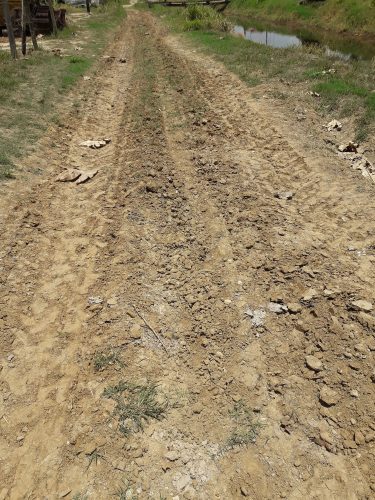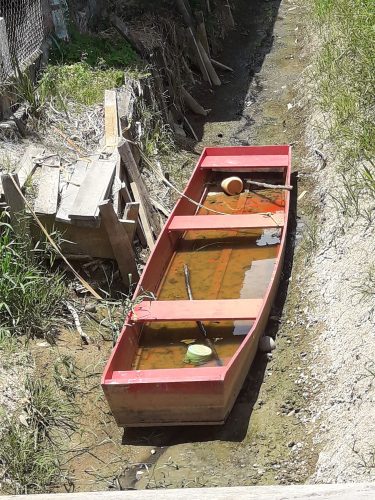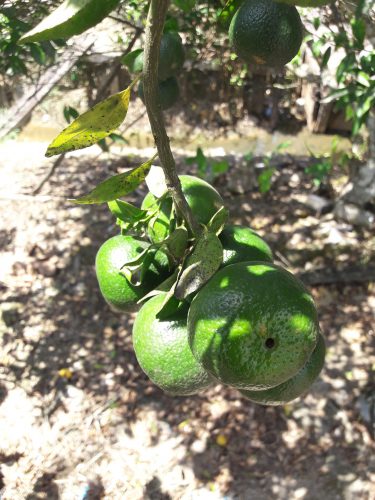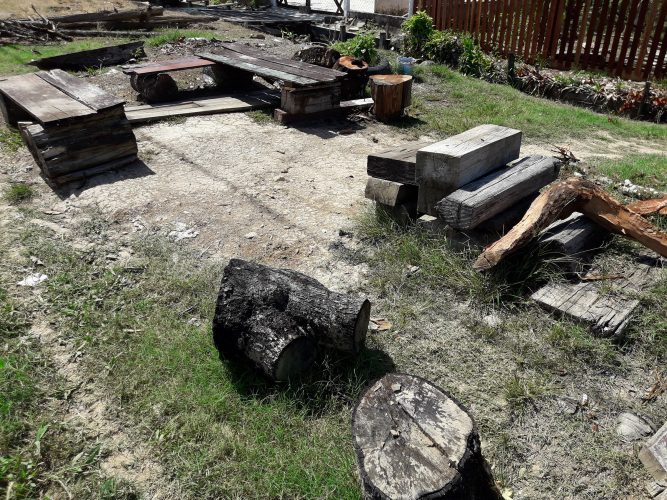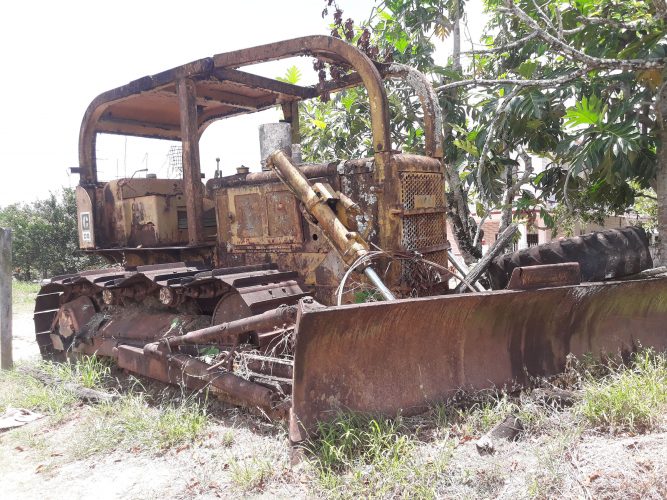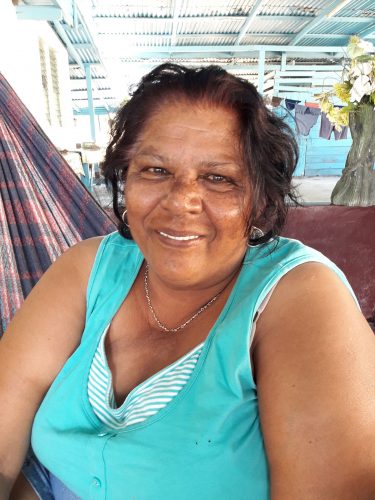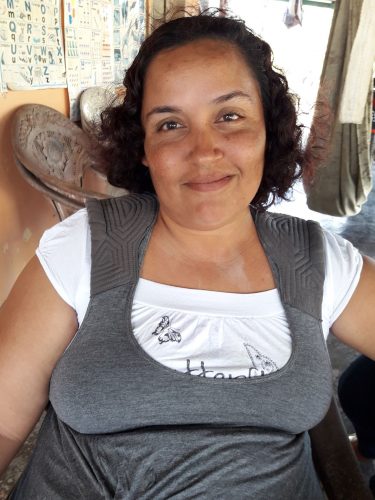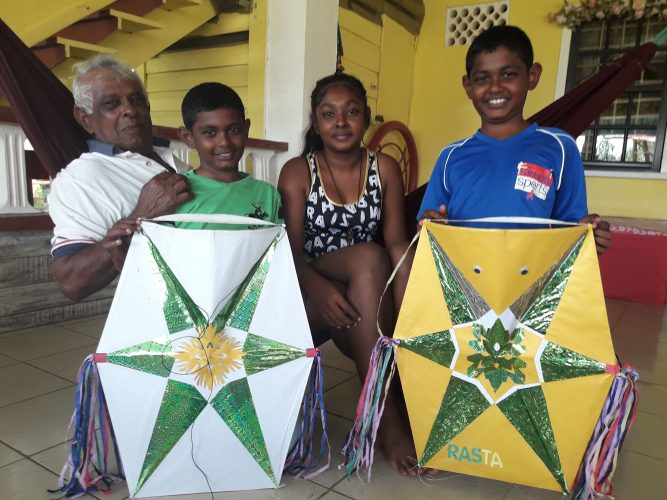Deep within Canal Number One, West Bank Demerara and three villages before the conservancy dam is the tiny village of Soesdyke, flanked by Endeavour and Good Land. For how long the village has existed, no one knows but Soesdyke has always been a haven for its more than 60 residents.
Many of the bridges leading to the village have gates, seemingly to keep out animals and possibly strangers. Yet though they seemed closed, they were not locked. The dam from which the bridges lead is imprinted with designs of tyres from the tractors that traverse it daily. In other places, the dam is broken up and has potholes and weeds.
All through the village, fruit trees grow along the dam. Those in season are laden with fruit. In other spaces, Hibiscus shrubs perk up the dreary-looking mud dam which resembles a cemetery for old, broken-down heavy duty machinery, trailers and vehicles.
Nand Ri Dilchand was resting in his hammock, while his wife sat nearby having lunch as two of his grandchildren sat around. He was the last boat captain to work the launch boats in the canal. Chand recalls taking his boat through the koker, along the Demerara River to Georgetown to sell provisions and fruits.
Dilchand was born in Tenez Ferme, situated a few villages up. He grew up farming like his ten other siblings did. Today of the 11 children his parents had, ten remain.
In 1970, Dilchand, his wife and their two children moved to Soesdyke. His parents had bought the plot of land in Soesdyke with a house already on it. The Dilchands’ last two children were born in Soesdyke.
“Life was good when we first come here; better than today. I worked the launch until they build the harbour bridge then sell it out and buy a truck. With the boat it used to take me three days in all because you had to work with tide; three days to get there, get the job done and get back home. With the truck now, it only take a few hours which mean getting there, off-loading, selling and coming back home,” Dilchand said.
“Man, the drive across the harbour bridge was smooth and nice at first,” he said. Then years later the bridge broke down and was inoperable for months. This was hard, he added. He had to take his truck to Vreed-en-Hoop to board the ferry then carry on his trade at the Stabroek Market before getting back home the same way.
Though Dilchand has never worked at any of the sugar estates, or for anyone else for that matter, he noted that many other persons long ago worked at the Leonora Sugar Estate and at the Wales Sugar Estate while many kept their farms as well. Dilchand has never known a life outside of farming and even today at 73 years old, he still farms with his wife; they plant only fruits now which they wholesale right at home.
“It’s quiet here. Everybody lives nicely together… is a peaceful area,” he said. He has relatives abroad in the United States, England and Canada and is always visiting. He has been on such visits 21 times already, but his farm always brought him back; he could never truly settle anywhere else in the world.
Aside from having a farm a mile long, living in Soesdyke has other advantages. For Dilchand, these include going on camping trips in the backdam with friends, catching sweet-water fish whenever he feels like it and hanging out with friends in the afternoon.
Though he is very contented, he worries over the no-subsidy system that was put in place for pensioners since the current government took over, adding that though he still sells, what he earns plus his pension are not nearly enough for paying bills.
His grandson nearby whispered to him about the blackouts and realizing how quiet it was, I asked the youngster, Sanat, whether there was a blackout right then and he replied in the affirmative. The boy said that it was the third day in a row that there was a blackout and though he was not fond of the internet or the television, it meant he could not use his PlayStation. In the meantime, his grandfather noted, he was riding about the place on his bike and flying his kite to make up for not being able to do so at Easter because of bad weather.
Sometime ago during a visit to a neighbouring village, there was talk of land masters in the area. Asked about the snake, Dilchand said that while he personally had never seen the reptile, his farmer friends had told him about one living on his farm. They claimed to have seen the huge snake coiled up in some grass on his farm. However, he strongly believes there is one having seen the disturbed bush and the trail it leaves. The trail, Dilchand said, proves that the snake is some ten inches in width.
Dilchand wishes to see development in the village including a better access dam to their homes and the one leading into the backdam.
Faye Chance and her family have been living in Soesdyke for ten years. They are tenants and will soon be moving to La Parfait Harmonie, but Soesdyke has become home.
“We’re from Bartica but because of jobs …my husband who worked in the interior didn’t get steady work. He came here and learnt to do construction and is now a contractor. I like a peaceful area and that’s what it is here,” Chance said.
Bartica was busier, she related. But the move meant more jobs are available and the level of schooling is better.
While in Bartica everything was in walking distance and they often went by foot, Soesdyke is far from church and the city and transportation, which is not easy, is required. “My husband had to buy a bike [motorcycle] to get to work cause here when you got to depend on transportation, you might just reach in to work to get knock off,” Chance said.
“We plan on moving to [La Parfait Harmonie]. I don’t know how we’ll make out. I’ll miss it here. Bartica is like living around family having grown up there but here is living in peace and quiet and having to move to a scheme, I don’t know how I’ll be able to settle there.”
Chance and her family attend the Universal Church in Georgetown and on Sundays they sometimes wait for long periods. It requires two sets of transportation to get to the city: first they have to get out to the Bagotville/Canal Number One junction and then travel from there to Georgetown.
Though she might not be living in Soesdyke for much longer, Chance would like to see improvements in the village. “One of the things I always say I would like for this community to achieve is a fun park for the kids; more activities for them where they can be more involved,” she said.
Chance would also like to see the dam built into a road, adding that it is a horrible sight when it rains.
Asked about the land masters, she said, “I don’t know what is the land master, but I know my landlord used to come sometimes and feed it, according to what he used to tell me, But it’s a couple of years since he last come to feed it and I wondering if it dead, or well it probably died from starvation by now because he stop coming anyway. When I go to my bed at nights, I pray and is till morning my eyes opening. Nothing bothers me here.”
Shivkumarie Bridgmohan lay in her hammock looking out. These days that is the most she does, having had kneecap replacements a year ago. Though she can walk, it is not always that simple for her.
She was born in Soesdyke in a different part of the village. She grew up with four sisters and three brothers. They attended the McGillivray Government School but she and her sisters were only allowed to go up to standard six. Her brothers went on to high school, but her parents never believed in higher education for girls. Once they learnt to read and write and sew, that was good enough. Having written and passed an exam for sewing, Bridgmohan left school.
The woman said they were put to do household chores like “daub the bottom house”, cook and look after younger relatives her mother had taken in. When she was 20 years old, she got married to someone chosen for her; their union produced four children.
It was after getting married, the woman noted, that she really worked. She planted provisions in the backdam, harvested them when the time came and sold them at Stabroek Market.
“I born here, I marry here, and I became a widow here. I love Soesdyke; this is really a nice area. When something’s wrong, everyone is out to see how they can help. The neighbours here always look out for one another,” the 64-year-old woman said.
Because of her knees she can no longer lift heavy loads, so whenever she buys her groceries from the van that passes along the canal road, the porters would help to carry them in. She reiterated that it was evidence of how nice the people are.
Regarding the development of the village, Bridgmohan applauded the work of the Guyana Power and Light in installing new electricity poles. She said they have always wanted telephones in the area and are still hoping for them.
Bridgmohan has her own land master, nothing like the ones that was mentioned before. “The land master is very good. I bought this place 42 years ago from an African teacher. The teacher told me about the land master. I never know about land master until she told me. She said it was vegetarian and that I need to feed it.”
Bridgmohan said the land master resembles a “really tall” African man. She leaves food for him on her farm; sometimes tennis roll and cheese with vodka. At other times she leaves fruits, chocolates and sweets. The woman added that she feeds him once a year towards the end of the year when the moon is full. At one point when she lived in another village, she said, she fed the land master parsad, adding that this land master was a snake. She said if it was not fed the land would not produce and the workers would complain and not want to work. She said he pays her a visit and would disappear after.
“I got a sister living in Canada and every time she come, she got to feed her land master. If you don’t feed it, you meeting disaster,” she warned.

